Index • FIDE 1948-1990 • Pre-FIDE • Highlights • Best games • News/Feedback • Gifts • Site map
World Chess Championship
|
||
At the time of the match, the Philippines had a population of 45 million. Chess as a sport was second in popularity only to basketball and the Philippine national chess team was the strongest in Asia. How did it happen that the first match was played in Asia for the World Chess Championship?
The bidding process was straightforward. Five weeks after the candidates final match, sealed bids were to be delivered by interested parties. The players then had two weeks to choose three venues, after which FIDE President Euwe would announce the site.
Seven bids were received. Substantial offers were made by Graz, Hamburg, Baguio City, and Tilburg, while token offers were made by Lucerne, Paris, and Il Ciocco. Neither player wanted to choose the other player's known preference. Karpov chose Hamburg, Baguio, Graz, while Korchnoi chose Graz, Baguio, Tilburg, Hamburg. Euwe chose the second site on each player's list and announced in March that the match would take place in the Philippines.
Baguio City is located in the mountains 250 km. north of Manila and at the time of the match had 100.000 full time inhabitants. Because it is cooler than Manila, with a constant temperature of 25 C., it is a popular resort area -- Philippine President Marcos had a second residence in Baguio. The rain season stretches from July to October, exactly those months for which the match was scheduled.
The two players had not met over the board since the 24 games in the 1974 candidates final. That match had been a defacto title match after Fischer refused to play in 1975.
Karpov was age 27 at the time of the match. After winning the championship title by forfeit, he had been more active in tournament play than any other world champion since FIDE had taken control of the title. He had participated in twelve tournaments, winning clear first in nine of them and finishing equal first in another.
Korchnoi observed his 47th birthday during the match. After defecting from the Soviet Union in 1976, he lived in the Netherlands, but was granted permission to live in Switzerland in September 1977. He had won the right to fight for the title by beating three Soviet players -- Petrosian, Polugaevsky, and Spassky -- in the candidates matches.
The prize fund was equivalent to 560.000 US$, of which 5/8 would go to the winner and 3/8 to the loser. In case of a forfeit, the loser would receive 10% of the prize fund for each win.
The first player to win six games, draws not counting, would win the match, so the number of games was unlimited. The last unlimited match had been the 1927 Alekhine - Capablanca title match, which also went to the first player to win six games. That match had gone to 34 games and had lasted eleven weeks.
Each player had the right to three timeouts during the first 24 games, then one timeout for each eight games. The games started at 17:00.
The Match Organizer was Florencio Campomanes, the Philippine delegate to FIDE, a former FIDE Zone 10 President, and one of FIDE's three Deputy Presidents. Edmondson considered that Campomanes had been the "world's number one promoter of chess for the past ten years".
The organizers provided for two seconds on each side. Karpov's seconds were GM Yuri Balashov, a longtime friend who had been 2nd to Karpov in the 1976 USSR Championship; GM Igor Zaitsev, who had assisted Petrosian and Polugaevsky in their matches against Korchnoi; and GM Mikhail Tal, who had long been on good terms with Karpov and on bad terms with Korchnoi. Semion Furman, Karpov's chief trainer in 1974, died three months before the start of the Baguio match.
The head of the Soviet delegation was Colonel Viktor D. Baturinsky (born 1914), Vice President of the USSR Chess Federation and Director of the Moscow Central Chess Club. Vitaly Sevastianov, President of the USSR Chess Federation and a former cosmonaut, was present at the opening ceremony and returned to Baguio toward the end of the match.
Korchnoi's seconds were GM Raymond Keene, who had studied German Literature at Cambridge; GM Michael Stean, a mathematics graduate of Cambridge; and Yakob Murey, an untitled emigree from the USSR to Israel with a reputation as an excellent analyst. Keene, Stean, and Murey had aided Korchnoi during the candidates matches against Polugaevsky and Spassky. Korchnoi's team was later joined by GM Oscar Panno.
The head of Korchnoi's delegation was Petra Leeuwerik, born in Austria with the maiden name Hajny, married to a Dutch national, divorced in 1976, and a citizen of the Netherlands living near Zurich. Edmondson wrote that she had been "seized by the Russians in the Soviet zone of Vienna after the war and given 20 years as a spy in the infamous Vorkuta labor camp. She served nine years there. [...] She met Korchnoi three months after his defection in 1976".
The Chief Arbiter was GM Lothar Schmid of West Germany, age 50. He had also served as Chief Arbiter for the 1971 Fischer - Petrosian candidates final match and for the 1972 Fischer - Spassky title match. Schmid was assisted by Deputy Arbiters Miroslav Filip of Czechoslovakia and Manuel Lara, the Secretary General of the Philippine Chess Federation. GM Filip was a Doctor of Law and had participated twice in candidate tournaments to determine the challenger for the title.
The match rules required an impartial jury to be composed of an arbiter, one representative for each player, one representative for the organizers, and three neutral members. The jury members were Schmid, Baturinsky, Leeuwerik, and Campomanes, along with neutral members Lim Kok Ann of Singapore, FIDE Zone 10 President and Chairman of the Jury; Ed Edmondson of the United States, former President and Executive Director of the United States Chess Federation; and Andrei Malchev of Bulgaria.
The opening ceremony at the Convention Center was attended by 2000 people, including President Marcos. When the Soviet National Anthem was announced the band mistakenly played the 'Internationale'. Korchnoi and Leeuwerik remained seated while everyone else stood. Korchnoi had selected the final movement of Beethoven's 9th symphony, 'Ode to Joy'.
Game 1 - Queen's Gambit Declined Korchnoi had White in the first game. Karpov played the Tartakower variation, an opening seen in the 1978 Korchnoi - Spassky candidates final. The game was an 18 move draw.
Game 2 - Ruy Lopez The opening became an Open Lopez, which had not been seen in the 1974 match. Korchnoi played the older 9...Bc5, followed up with the rarely seen 11...Bf5, and uncorked a novelty with 14...d4. The game was drawn after 29 moves.
Game 3 - Nimzo Indian Defence The players again produced an opening which had not been seen in the previous match. Karpov played a novelty with 9...a5. By move 24 Korchnoi had an advantage, but was unable to win. The game was agreed drawn after 30 moves in the face of a move repetition.
Game 4 - Ruy Lopez Korchnoi avoided the novelty in game 2 and played a 14th move which theory considered inferior. He had given the move '?' in ECO, but evidently discovered that theory was faulty, so the move set a trap for Karpov. Karpov avoided the theoretical line and the game was drawn on the 19th move.
Game 5 - Nimzo Indian Defence The players followed game 3 until Karpov varied on his 5th move. Korchnoi launched a pawn attack against the castled king. By move 30 Korchnoi had two bishops vs. two knights plus R+Q each. Karpov suddenly opened his king's position on move 37 and sealed on the 42nd move, to produce the first adjournment in the match. In the second session, Korchnoi got into time trouble and overlooked a win by checkmate on move 55.
| Game 5 : Korchnoi - Karpov |
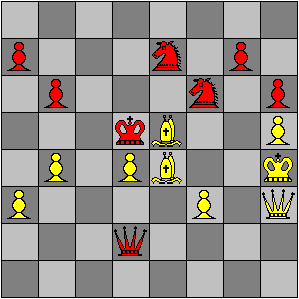
|
| after 55.Bg6-e4+ |
| (55.Bf7+ Kc6 56.Qe6+ mates) |
|
|
The queens were exchanged, leaving an endgame of B+Pabdh vs. N+Pabgh. Karpov sacrificed his N for the d and h pawns. A few more pawns were cleared off the board and the game entered an endgame of B+Pa vs. Pab with a bishop of the wrong color. Korchnoi continued to move 92, when he sealed for another adjournment, which was continued after game 6.
The endgame had already been analyzed by Averbakh in 1954 as a theoretical draw. The game was drawn when Korchnoi stalemated Karpov on the 124th move. The game, which lasted twelve hours, was the longest game ever seen in world championship matches, exceeding the 121 moves played by Tal and Botvinnik in the 20th game of their 1961 return match.
Game 6 - English Opening The opening followed game 9 of the 1974 match, where Korchnoi had White. On the 9th move he was the first to vary in the present game. Both players were tired after the long fifth game and the game was drawn on the 23rd move.
Game 7 - Nimzo Indian Defence Karpov varied from game 4 on his 4th move and both players veered into uncharted territory on their 6th moves. By move 16 Karpov was ready to offer an exchange in return for strong center pawns. Korchnoi had great difficulty finding a good plan and drifted into a position where Karpov had passed pawns on c4 and d4. By the time Korchnoi sealed his 41st move, the pawns had both advanced another rank, but White had a compensating attack against the Black king. Most observers expected Karpov to win, but he offered a draw as soon as he saw the sealed move.
| Game 7 : Korchnoi - Karpov |
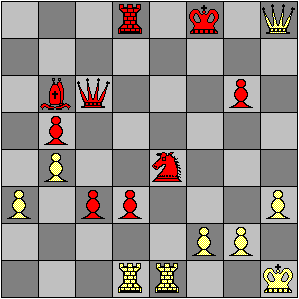
|
| after 42.Qh7-h8+ |
| (sealed; drawn without resumption) |
|
|
Game 8 - Ruy Lopez Starting with game 8, Karpov refused to shake hands with Korchnoi. Karpov followed game 4 until his 9th move and Korchnoi played a novelty (10...g7-g6) which turned out to be a dubious opening innovation. Karpov answered by offering a pawn. Korchnoi accepted it and quickly fell victim to a crushing attack.


|
| Game 8 : Karpov - Korchnoi |
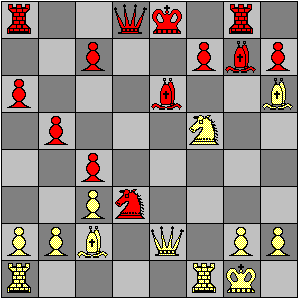
|
| after 18.Bc1-h6 |
|
|
The string of consecutive draws was finally broken and Karpov led 1-0.
Games 9-17; Karpov leads 4-1
Game 9 - Queen's Gambit Declined Korchnoi varied from the Queen's Gambit of game 1 with 5.Bf4, which had was new to his opening repertoire. Karpov played a dubious novelty on his 14th move and Korchnoi obtained a strong positional advantage. In his usual time trouble, Korchnoi missed a winning attempt just before the time control. Karpov sealed and the draw was agreed before the second session started.
Game 10 - Ruy Lopez The players followed game 8 until Korchnoi varied on his 10th move. Karpov played a stunning novelty on the 11th move, sacrificing a knight, but Korchnoi found a good response.
| Game 10 : Karpov - Korchnoi |
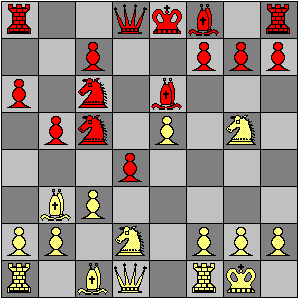
|
| after 11.Nf3-g5 |
|
|
Karpov gradually let his advantage slip in the endgame and Korchnoi was somewhat better by the time the game was adjourned. The game was agreed drawn on the 44th move.
Game 11 - Sicilian Defence Korchnoi opened 1.g3, which transposed into a Sicilian. He played an unusual opening, which Karpov did not defend very well. In a difficult position, Karpov blundered.
| Game 11 : Korchnoi - Karpov |
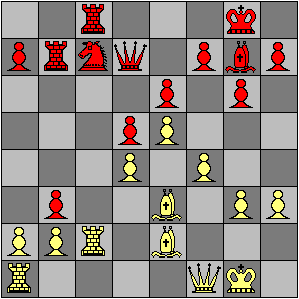
|
| after 25...b4-b3? |
|
|
He was forced to give up the exchange and resigned after 50 moves. The score was 1-1.
Karpov took a timeout
Game 12 - Ruy Lopez Karpov varied from previous Open Lopezes on his 9th move. The game followed a path well known to opening theory where Korchnoi was the first to vary with 16...Qb6. Korchnoi played a weakening move on his kingside, but continued accurately.

|
| Game 12 : Karpov - Korchnoi |
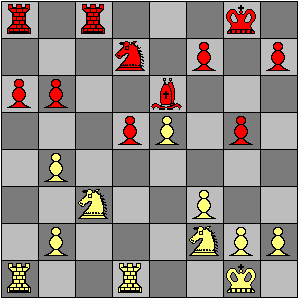
|
| after 23.Nd3-f2 |
|
|
The game reached a clearly drawn position, but there were some difficulties in offering and accepting the draw.
Game 13 - Queen's Gambit Declined Korchnoi returned to 5.Bg5 in the Queen's Gambit and varied from game 1 on his 7th move. The players could have played into a line seen in the Korchnoi - Spassky candidates final, but Korchnoi varied again. The play revolved around Black's efforts to free his game with ...c5 until Karpov pushed ...b5. He hoped to provoke a crisis before the time control, thereby taking advantage of Korchnoi's usual time trouble. Korchnoi sacrificed an exchange to play against Black's weak pawns. Korchnoi sealed his 41st move after thinking for 40 minutes.
| Game 13 : Korchnoi - Karpov |

|
| after 41.Ra2-a7 (sealed) |
|
|
The game was not resumed the next day, Korchnoi requesting a timeout.
Game 14 - Ruy Lopez The 14th game started before the second session of game 13. It followed game 4 until Karpov varied on his 13th move. The players followed a line which Korchnoi had analyzed for ECO. At the point where Korchnoi had judged the position as 'unclear', Karpov attempted to show that, due to an ongoing initiative, it was better for White. On the 20th move, the game settled into a 2R+B+7P endgame with opposite colored bishops. Korchnoi failed to find the best defensive plan, and allowed Karpov to sacrifice the exchange for two pawns.

|
| Game 14 : Karpov - Korchnoi |
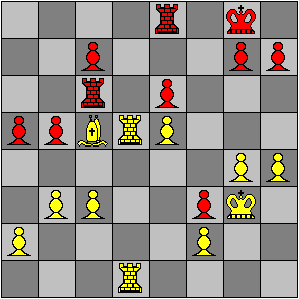
|
| after 29.Rd4-d5(xB) |
|
|
By the time Karpov sealed, he had won a third pawn.
'Black Sunday' for Korchnoi The second session of game 13 resumed in an advantageous position for Korchnoi, but Karpov continued correctly. Korchnoi was unable to find a winning line and started to take unusual risks. Some observers considered that he may have tried too hard to find a win, influenced by the unfavorable adjourned position of game 14. On the last move before the second time control, he blundered, allowing his queen to be trapped. He resigned on his 63nd move.
In the second session of game 14, Korchnoi resigned on the 50th move. In one day the match score had gone from 1-1 to 3-1 in favor of Karpov.
Game 15 - Catalan Opening Korchnoi avoided the Queen's Gambit by playing 5.g3. Karpov sacrificed a pawn in the opening, which Korchnoi returned a few moves later. On move 16 Korchnoi could have forced a draw by perpetual check, but he chose to play on. The game was drawn on the 25th move in view of a R+4P ending with all the pawns on the kingside.
Game 16 - French Defence After the unsatisfactory result with the Ruy Lopez in game 14, Korchnoi returned to his favorite French, which had been seen many times in the 1974 match. Karpov varied on his 5th move. By move 12 the players had swapped down to 2R+B+N+6P, with an isolated d-pawn for Korchnoi. By move 27 the minor pieces had also disappeared from the board. Korchnoi sealed his 42nd move, but the game was not continued.
Game 17 - Nimzo Indian Defence The opening followed game 7 until Karpov varied on his 8th move. By move 32 the position was 2R+Pagh vs. R+2N+Pgh and a likely draw. Korchnoi avoided several drawing continuations before blundering into a mate on the 39th move.
| Game 17 : Korchnoi - Karpov |
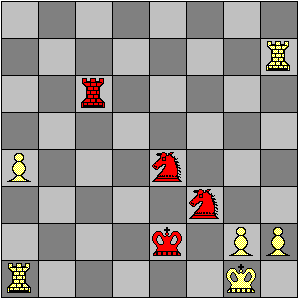
|
| after 39...Nd2-f3+ 0-1 |
|
|
"If this game does not teach Korchnoi to stay out of time trouble, he will never learn. He lost a position it seemed impossible to lose. What is the use of absorbing all the little details of the position at move 13, what is the use of all your brilliant planning around move 26, if you overlook a mate in three on move 39?" - Bent Larsen in his book on the match.
The score was 4-1. Korchnoi took two consecutive timeouts after this game.
Games 18-27; Karpov leads 5-2
Game 18 - Pirc Defence Korchnoi switched to the Pirc, which he had not previously played against Karpov, who gained a small advantage. He failed to press hard enough and missed the best continuation just before adjournment. When Karpov sealed his 41st move, the position was a R+B+4P endgame where all Korchnoi's pawns were isolated. In the second session, Korchnoi defended accurately and the game was drawn after 64 moves.
Karpov took a timeout.
Game 19 - Catalan Opening The players followed game 15 by transposition until Korchnoi steered into a different variation on his 6th move. Both players continued accurately, with Karpov accepting hanging pawns. The game became a 2R+B+5P ending where Karpov had a small advantage. It was far from enough to win and the game was drawn just before the time control was reached.
Game 20 - Caro-Kann Defence Korchnoi again answered 1.e4 with a move not yet seen in the two matches. He chose a drawish variation which gives White a queenside pawn majority. In an equal position, he gave up a queenside pawn in exchange for a kingside pawn. With only some vague counterchances on the kingside, he was in danger of losing. Karpov thought for 30 minutes on his sealed 42nd move. Keene said of the adjourned position, 'If Korchnoi pulls off a miracle by saving this game, I'll join the Ananda Marga'.
By snatching another pawn on his sealed move, Karpov would have risked complications, but analysis shows that these were always in his favor. Instead, he played safely, pushing pawns to b7 and d7. Karpov again missed the best line and allowed Korchnoi to escape. The draw was agreed after 63 moves. Keene joined the Ananda Marga yoga classes the next day.
Game 21 - Queen's Gambit Declined Korchnoi repeated the line seen in game 9, allowing Karpov to play a novelty on the 10th move. A few moves later Karpov sacrificed a knight, which Korchnoi declined to accept. Korchnoi defended accurately and when the complications were over, he was a pawn ahead.

|
| Game 21 : Korchnoi - Karpov |
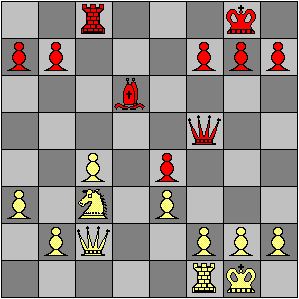
|
| after 23.0-0 |
|
|
By move 30, the game was in a R+N+6P vs. R+B+5P ending. When Korchnoi sealed his 42nd move, he had a solid extra pawn on b7, threatening to queen. In the second session, Karpov tried many resources. On each move, both players had to calculate various sacrifices for Black and to evaluate whether different theoretical endings were won or drawn. Korchnoi worked his way through the traps and Karpov finally abandoned the game on his 60th move. The score was now 4-2 in Karpov's favor. This was one of the best played games of the match.
Game 22 - French Defence The opening followed game 16 until Korchnoi varied on his 6th move. Karpov gained a small advantage in the opening and castled queenside for the first time in the match for either player. Korchnoi decided to exchange queens and try to hold the endgame with his isolated d-pawn. As the pressure mounted, he sacrificed it to set up a blockade on d5, which Karpov broke by returning the extra pawn, thereby getting a won position.
For some reason, Karpov declined to adjourn, missed an easy win, and gradually let his winning advantage slip away. By the time Korchnoi sealed his 47th move, he could sacrifice a piece to attain a fortress position, so the win was no longer there. The game was agreed drawn during the second session after the 64th move. Korchnoi had narrowly avoided defeat for the second consecutive game with the Black pieces.
Game 23 - Queen's Gambit Declined Karpov avoided his novelty of the 21st game and followed game 9 until he varied with a queen retreat on his 13th move. Korchnoi gained a slight advantage with a queenside majority against a blockaded d-pawn. Karpov defended accurately and the game dwindled to a drawn R+P endgame. The point was split just after the first time control was reached.
Game 24 - Ruy Lopez Korchnoi steered into the Open Lopez for the first time since the 14th game and varied on his 9th move. He managed to play the thematic ...c5 early in the game and came out of the opening with a slight advantage. Karpov made an attempt to win and got into trouble, but Korchnoi simplified too quickly. The game was adjourned in a drawish R+N+4P ending. The players agreed to the draw a few moves into the second session.
With this game the match reached the maximum length of all matches played since 1951. Karpov took a timeout because a plane woke him up too early in the morning.
Game 25 - English Opening Karpov repeated an opening last seen in game 9 of the 1974 match and Korchnoi varied immediately. The opening became a Reversed Sicilian. Karpov first gained a small advantage with the two bishops, then a large advantage when he took control of the open c-file. For some reason, Karpov missed easy wins on his 36th and 38th moves.
| Game 25 : Korchnoi - Karpov |
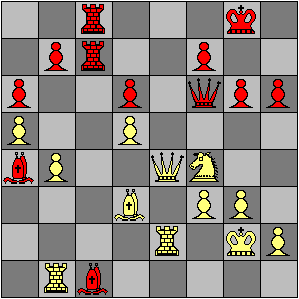
|
| after 36.Qe3-e4 |
|
(36...Kf8 37.b5 axb5 38.Qb4 Rc5; both 36...Re8 and 38...Bxf4 win) |
|
|
Just before the time control, Korchnoi sacrificed an exchange to rip open Black's king position. Karpov returned the exchange and Korchnoi sealed his 42nd move in an advantageous position. In the second session Karpov defended accurately and the game settled into a R+N vs. R+B endgame, with Korchnoi retaining an extra pawn. The game was drawn after 80 moves.
Game 26 - English Opening Karpov repeated 1.c4, which had been last seen in the sixth game. Korchnoi varied on his second move. After the see-saw battle in the previous game, both players continued cautiously. A quiet opening was followed by a quiet middlegame and the draw was agreed after the 27th move.
Game 27 - English Opening The players repeated an opening where Korchnoi had White in the 9th game of the 1974 match and where Karpov had White in the 6th move of this match. Korchnoi varied from both games with 5.Nd5. The four knights disappeared from the board by move 7. Korchnoi outplayed Karpov in the opening and gained a positional advantage, but around move 17 he started to play without a real plan. Karpov eliminated his positional weakness, grabbed the center, and gained an advantage. Korchnoi lost a pawn unnecessarily and without compensation. Karpov sealed his 41st move, but Korchnoi resigned before the second session. The resignation was done in an unusual way.
The score was 5-2 which meant that Karpov now needed only one more full point to win the match.
Games 28-31; Korchnoi makes it 5-5
Game 28 - Ruy Lopez The opening followed game 14 until Korchnoi varied on his 9th move. He declined to castle. By move 28 the game had become a 2R+N+6P ending, both players having pawn majorities on opposite wings. Karpov's position was slightly inferior and he offered a draw by triple repetition which Korchnoi declined. Korchnoi gradually penetrated White's position and he broke through with his 37th move.

|
| Game 28 : Karpov - Korchnoi |
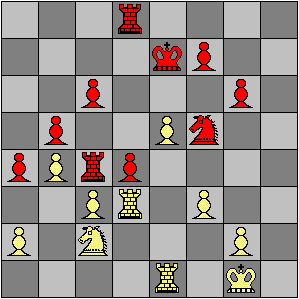
|
| after 37...d5-d4 |
|
|
The knights were exchanged before Korchnoi sealed his 42nd move, which he considered for 30 minutes. Seeking complications, Karpov declined to play the most natural continuation in the second session. Korchnoi won a pawn which gave him connected passed pawns on the a and b files. Karpov tried to find a perpetual check, but finally resigned on his 62nd move.
This was Korchnoi's first win ever against Karpov with the Black pieces and the match score was now 5-3.
Game 29 - English Opening The game was postponed twice -- first for a technical timeout and then when Korchnoi requested a timeout. There was an earthquake during the rest period.
Korchnoi varied from previous games with 3.e4. The game became an approximately equal R+B+N+6P ending by move 28. Korchnoi weakened his kingside pawn structure in order to break through to the eighth rank with his rook. He sealed his 41st move. By the second time control on move 56, the position had reduced to R+B vs. R+N with three pawns each.
| Game 29 : Korchnoi - Karpov |

|
| after 57.Kg3-g4 |
|
|
Korchnoi had a significant advantage due to his more active king position and the domination of his bishop over Karpov's knight. Karpov missed the best defense and by the third time control on move 72, Korchnoi had a won game. Karpov resigned on his 79th move.
This was Korchnoi's second consecutive win and brought the match score to 5-4.
Game 30 - English Opening Karpov opened 1.c4 for the third time in the match and Korchnoi replied 1...Nf6 for the first time. Both players proceeded carefully and by move 30 reached an ending of R+6P with Korchnoi having an outside passed a-pawn. He offered a draw after his 34th move, which Karpov declined. Karpov sealed his 42nd move, but the game was agreed drawn before the second session.
Game 31 - Queen's Gambit Declined Korchnoi chose the Exchange Variation for the first time in either match. By move 16 the middlegame was almost an endgame with 2R+2N vs. 2R+B+N and seven pawns each. Karpov prevented a standard minority attack, after which Korchnoi played for an e4 pawn break. Karpov prevented this as well, so Korchnoi played for a kingside pawn break. On the first move after the time control, Karpov allowed Korchnoi to make the risky e4 break, which Korchnoi accepted. By the time Karpov sealed his 47th move, the players had reached an endgame of R+6P each.
At some point in the second session, Karpov played incorrectly, but the various commentators do not agree which move was the decisive error. Larsen wrote, 'This ending will be analyzed for years' and quoted Keene as saying 'This game was 80% drawn; they don't know how to analyze'.

|
| Game 31 : Korchnoi - Karpov |
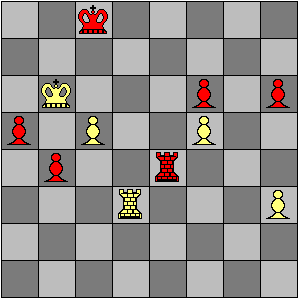
|
| after 57...a6-a5 |
| (57...Rc4 holds the draw - Filip) |
|
|
Korchnoi quickly broke through the queenside, establishing a strong passed pawn on c6 which gave simultaneous threats to promote or mate with the rook. Karpov gave up two pawns and resigned on his 71st move.
Although he was trailing by 5-2 after the 27th game, Korchnoi had evened the score at 5-5 in the next four games. He said, 'The next game decides -- it's like a lottery'.
Game 32; Karpov wins 6-5
Game 32 - Pirc Defence The opening started as a Pirc but transformed into a Benoni (without c4) when Korchnoi played 6...c5. Korchnoi played a strange sequence with 11...Nf6-h5 and 12...Nh5-f6, giving away a tempo. On his 24th move, he moved his queen to a8, far way from the kingside, where Karpov was massing his pieces. Karpov immediately broke in the center with e5, with mate threats in many lines.


|
| Game 32 : Karpov - Korchnoi |
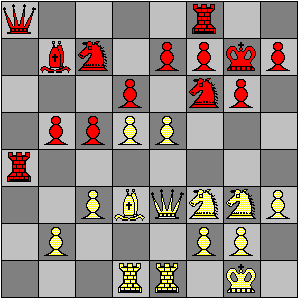
|
| after 25.e4-e5 |
|
|
He still had one hour on his clock to reach move 40, while Korchnoi had less than 20 minutes. Karpov won a pawn and Korchnoi failed to find the best counterplay. Korchnoi sealed his 41st move, but resigned before the second session.
After three months of play, Karpov had won the match by the narrow score of 6-5.
A bitter match
The 1978 Karpov-Korchnoi match was one of the most bitter chess matches ever played. The Soviet chess machine could not let their star lose to a defector. It was Karpov's first defense of his title since winning by default from Fischer.
With only a few exceptions, the games were hard fought. Many games went into the deep endgame before they were agreed drawn.
Contenders for the title of world chess champion necessarily have strong wills to win at chess and are extremely competitive. During a title match, they sit for weeks and months across a table from each other, engaged in a battle of intellect while a ticking clock limits their thinking time. This induces intense nervous and psychological pressure, which must invariably escape in some fundamental way. During the 1978 title match, the pressure escaped in the form of disputes and controversies which may seem amusing or puzzling now, but which were far from amusing when they occurred.
Dr. Zukhar, a parapsychologist and member of Karpov's delegation, was accused of sitting in the audience and interfering with Korchnoi's concentration. When Korchnoi was unable to have him removed, he engaged the Ananda Marga, a religious sect, to counterbalance the 'bad vibrations'. The Ananda Marga were later driven out of the playing hall by Chief Organiser F. Campomanes. We have separated the controversies -- Dr. Zukhar, the Ananda Marga, yogurt, and the rest -- from the games, and placed them on a separate page.
The following table shows the dates on which the match games were played.
| Month/Week | : | Tu | We | Th | Fr | Sa | |
|---|---|---|---|---|---|---|---|
| Jul | 18-22 | : | 01 | -- | 02 | -- | 03 |
| 25-29 | : | 04 | -- | 05 | -- | 06 | |
| Aug | 01-05 | : | 07 | -- | 08 | -- | 09 |
| 08-12 | : | 10 | -- | 11 | -- | -- | |
| 15-19 | : | 12 | -- | 13 | -- | 14 | |
| 22-26 | : | 15 | -- | 16 | -- | 17 | |
| 29-02 | : | -- | -- | -- | -- | 18 | |
| Sep | 05-09 | : | -- | -- | 19 | -- | 20 |
| 12-16 | : | 21 | -- | 22 | -- | 23 | |
| 19-23 | : | 24 | -- | -- | -- | 25 | |
| 26-30 | : | 26 | -- | 27 | -- | 28 | |
| Oct | 03-07 | : | -- | -- | -- | -- | 29 |
| 10-14 | : | 30 | -- | 31 | -- | -- | |
| 17-21 | : | 32 | -- | -- | -- | -- | |
|
WCC Index |
Results |
|
Previous |
Next |